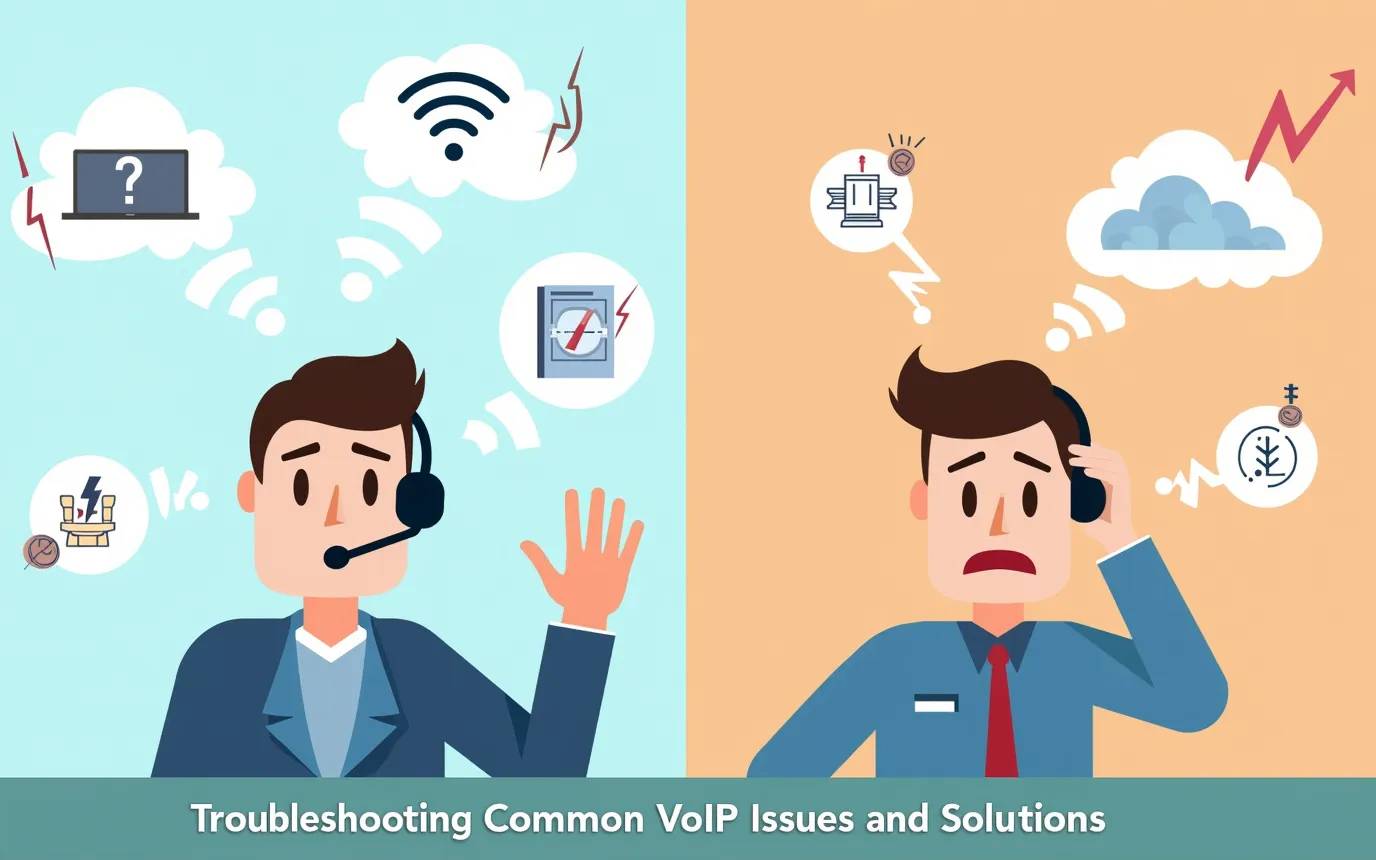Voice over Internet Protocol (VoIP) technology has revolutionized communication by allowing voice calls to be transmitted over the Internet rather than traditional phone lines. This technology offers cost savings, flexibility, and advanced features for businesses and individuals alike.
As VoIP systems become increasingly integral to daily operations, addressing issues promptly is crucial. Unresolved problems can lead to poor call quality, dropped connections, and communication breakdowns, potentially impacting productivity and customer satisfaction.
This article aims to provide a comprehensive guide to troubleshooting common VoIP issues. By identifying typical problems and offering step-by-step solutions, we empower users to maintain reliable, high-quality VoIP services and minimize disruptions to their communication needs.
Certainly, I’ll provide a concise overview of VoIP basics covering those three key points:
Understanding VoIP Basics
A. How VoIP works
VoIP converts analog voice signals into digital data packets. These packets are then transmitted over the internet or other IP networks. At the receiving end, the packets are reassembled and converted back into voice signals. This process allows for voice communication to occur using internet infrastructure rather than traditional telephone lines.
B. Key components of a VoIP system
- IP phones or softphones (software-based phone applications)
- VoIP server or IP PBX (Private Branch Exchange)
- Gateway (for connecting to traditional phone networks)
- Internet connection (preferably high-speed and reliable)
- Routers and switches configured for VoIP traffic
C. Common VoIP protocols
- Session Initiation Protocol (SIP): Widely used for initiating, maintaining, and terminating voice sessions
- H.323: An older protocol suite still used in some enterprise systems
- Real-time Transport Protocol (RTP): Used for delivering audio and video over IP networks
- Secure Real-time Transport Protocol (SRTP): An encrypted version of RTP for added security
[Read Also: Setting Up VoIP: A Step-by-Step Guide for Small Businesses]
Call Quality Issues in VoIP Systems
A. Echo
1. Causes of echo
- Acoustic echo: Sound from the speaker being picked up by the microphone
- Electrical echo: Signal reflections in the network or faulty hardware
- Impedance mismatch: Inconsistencies in electrical characteristics of devices
2. Troubleshooting steps
- Isolate the source: Determine if the echo is on the local or remote end
- Check hardware: Ensure proper functioning of headsets, phones, and cables
- Adjust volume levels: Reduce speaker volume to minimize acoustic feedback
- Verify network conditions: Check for packet loss or high latency
3. Solutions for echo reduction
- Enable echo cancellation features in VoIP software or hardware
- Use echo-cancelling headsets or handsets
- Implement acoustic echo cancellation (AEC) algorithms
- Adjust echo tail length in VoIP system settings
B. Jitter
1. Explanation of jitter in VoIP context
Jitter refers to the variation in the delay of received packets. In VoIP, it can cause audio distortion, stuttering, or out-of-sequence playback.
2. Identifying jitter issues
- Choppy or robotic-sounding audio
- Words or syllables cutting out during conversations
- Inconsistent call quality
3. Jitter buffer configuration
- Implement adaptive jitter buffers that dynamically adjust to network conditions
- Configure static jitter buffer size based on network performance metrics
- Balance buffer size to minimize both latency and packet loss
C. Latency
1. Causes of high latency
- Network congestion
- Inefficient routing
- Inadequate bandwidth
- Overloaded VoIP servers
- Excessive network hops
2. Measuring latency
- Use ping tests to measure round-trip time (RTT)
- Employ specialized VoIP testing tools for end-to-end latency measurement
- Monitor Mean Opinion Score (MOS) for overall call quality assessment
3. Techniques to reduce latency
- Prioritize VoIP traffic using Quality of Service (QoS) settings
- Optimize network routing to minimize hops
- Upgrade bandwidth or internet connection speed
- Use wired connections instead of Wi-Fi when possible
- Choose geographically closer VoIP servers or data centers
[Read Also: Understanding the Basics of VoIP: A Beginner’s Guide]
Connectivity Problems in VoIP Systems
A. Dropped Calls
1. Network-related causes
- Insufficient bandwidth
- Network congestion
- Packet loss
- Unstable internet connection
2. Hardware-related causes
- Faulty routers or switches
- Defective IP phones or headsets
- Overloaded VoIP servers
3. Troubleshooting steps
- Check internet connection stability and speed
- Monitor network performance metrics (packet loss, jitter, latency)
- Verify hardware connections and functionality
- Review VoIP server logs for errors or capacity issues
- Test with alternative devices to isolate hardware problems
B. One-Way Audio
1. Common causes
- Incorrect firewall settings
- Network Address Translation (NAT) issues
- Asymmetric routing
- Codec mismatch between endpoints
- Faulty microphone or speaker on one end
2. Diagnosing one-way audio issues
- Determine which direction the audio is failing (incoming or outgoing)
- Check firewall settings for both incoming and outgoing audio streams
- Verify NAT traversal settings in VoIP configuration
- Ensure consistent codec settings across all endpoints
- Test microphone and speaker functionality independently
3. Solutions for restoring two-way communication
- Configure firewall to allow bidirectional VoIP traffic
- Implement proper NAT traversal techniques (STUN, TURN, or ICE)
- Align codec settings across all devices and the VoIP server
- Replace faulty hardware components
- Use VoIP-specific diagnostic tools to analyze and resolve audio path issues
C. Unable to Make or Receive Calls
1. Registration issues
- Incorrect SIP credentials
- Server authentication problems
- Expired accounts or subscriptions
- DNS resolution failures
2. Firewall and NAT traversal problems
- Blocked SIP or RTP ports
- Improper NAT configuration
- Lack of ALG (Application Layer Gateway) support in firewalls
3. Troubleshooting steps
- Verify SIP account credentials and registration status
- Check DNS settings and server addresses
- Review firewall rules and ensure necessary ports are open (typically 5060 for SIP, 10000-20000 for RTP)
- Enable SIP ALG on firewalls or routers if supported
- Implement proper NAT traversal techniques
- Test basic network connectivity to the VoIP server
- Review server logs for registration attempts and failures
- Temporarily disable security software to isolate potential conflicts
Audio Quality Issues in VoIP Systems
A. Static or Noise on the Line
1. Identifying sources of interference
- Electromagnetic interference (EMI) from nearby electronic devices
- Radio Frequency Interference (RFI) from wireless devices
- Ground loop issues in electrical systems
- Network congestion or low-quality internet connection
- Acoustic echo or feedback from speaker-microphone proximity
2. Hardware vs. software causes
Hardware causes:
- Faulty or low-quality microphones, headsets, or IP phones
- Damaged Ethernet cables or connections
- Defective network interface cards (NICs)
Software causes:
- Outdated or corrupted audio drivers
- Improperly configured audio settings in VoIP software
- Codec incompatibilities or misconfigurations
3. Solutions for clearer audio
- Relocate VoIP equipment away from potential sources of EMI/RFI
- Use shielded Ethernet cables and properly grounded electrical outlets
- Upgrade to higher quality microphones, headsets, or IP phones
- Update audio drivers and VoIP software to the latest versions
- Adjust audio settings, including microphone sensitivity and noise suppression
- Implement acoustic echo cancellation (AEC) and noise reduction algorithms
- Ensure sufficient bandwidth for high-quality audio transmission
B. Choppy or Robotic Voice
1. Packet loss explanation
Packet loss occurs when data packets fail to reach their destination during transmission. In VoIP, this results in missing pieces of audio, causing a choppy or robotic-sounding voice. Severe packet loss can lead to unintelligible speech or dropped calls.
2. Diagnosing packet loss
- Use network monitoring tools to measure packet loss percentage
- Perform ping tests to check for consistent packet delivery
- Analyze call quality metrics provided by VoIP systems
- Listen for characteristic symptoms: words cutting out, robotic voice, or brief silences in conversation
3. Strategies to minimize packet loss
- Prioritize VoIP traffic using Quality of Service (QoS) settings on routers and switches
- Increase bandwidth or upgrade internet connection to handle VoIP traffic
- Use wired Ethernet connections instead of Wi-Fi when possible
- Optimize network infrastructure to reduce network hops and potential points of failure
- Implement Forward Error Correction (FEC) to recover from minor packet loss
- Configure jitter buffers to compensate for varying packet arrival times
- Consider using more robust codecs that can better handle packet loss (e.g., Opus)
- Regularly maintain and update network equipment and VoIP software
Device and Configuration Issues in VoIP Systems
A. Headset Problems
1. Compatibility issues
- Incompatibility between headset and VoIP software or device
- Connector type mismatches (e.g., USB vs. 3.5mm jack)
- Bluetooth pairing problems with wireless headsets
2. Driver updates
- Outdated or corrupted audio drivers
- Locating and installing the correct drivers for your operating system
- Automatic vs. manual driver update processes
3. Troubleshooting steps
- Check physical connections and try alternative ports
- Verify headset is set as the default audio device in the operating system settings
- Test the headset with another device to isolate the issue
- Update or reinstall headset drivers
- Adjust audio settings in VoIP software
- For wireless headsets, ensure proper pairing and sufficient battery charge
B. Softphone Configuration
1. Common configuration mistakes
- Incorrect SIP server settings or credentials
- Misconfigured audio input/output devices
- Improper codec selection
- Firewall blocking VoIP traffic
- Insufficient bandwidth allocation
2. Optimizing softphone settings
- Adjust audio settings for optimal quality (e.g., echo cancellation, noise reduction)
- Configure appropriate codec preferences based on network conditions
- Set up Quality of Service (QoS) tagging for VoIP traffic
- Optimize jitter buffer settings
- Enable encryption for secure communications
3. Updating softphone software
- Regularly check for and install software updates
- Review changelogs for new features or bug fixes
- Follow best practices for testing updates in non-production environments
- Configure automatic updates if available
- Keep backup configurations before major updates
C. IP Phone Issues
1. Power and connectivity problems
- Verify power supply or Power over Ethernet (PoE) functionality
- Check Ethernet cable connections
- Ensure network switch ports are correctly configured for VoIP
- Troubleshoot DHCP issues for IP address assignment
2. Firmware updates
- Identify the current firmware version and available updates
- Follow the manufacturer’s recommended update procedures
- Address potential issues during firmware updates (e.g., power interruptions)
- Verify phone functionality after updates
- Roll back firmware if the new version introduces issues
3. Factory reset procedures
- Understand when a factory reset is necessary
- Document current configuration settings before reset
- Follow manufacturer-specific reset instructions
- Reconfigure phone settings after reset
- Verify registration and functionality with VoIP service
Network-related VoIP Problems
A. Bandwidth Issues
1. Calculating VoIP bandwidth requirements
- Determine codec bitrate (e.g., G.711 at 64 kbps, G.729 at 8 kbps)
- Account for IP overhead (typically 20-50% additional bandwidth)
- Consider the number of concurrent calls
- Factor in other network traffic
- Example calculation: 20 concurrent calls using G.711 = (64 kbps * 1.2 overhead) * 20 = 1.536 Mbps
2. Identifying bandwidth bottlenecks
- Use network monitoring tools (e.g., Wireshark, PRTG, SolarWinds)
- Analyze network utilization during peak hours
- Check for bandwidth-intensive applications or services
- Monitor WAN link utilization
- Perform speed tests to verify available bandwidth
3. Optimizing network for VoIP traffic
- Implement traffic shaping and prioritization
- Use compression techniques where appropriate
- Consider upgrading the internet connection or adding dedicated VoIP circuits
- Optimize codec selection based on available bandwidth
- Implement call admission control to prevent oversubscription
B. QoS (Quality of Service)
1. Importance of QoS for VoIP
- Ensures voice packets are prioritized over less time-sensitive data
- Reduces latency, jitter, and packet loss for voice traffic
- Maintains call quality during periods of network congestion
- Allows for efficient use of available bandwidth
2. Configuring QoS on routers and switches
- Identify and mark VoIP traffic (using DSCP or CoS)
- Create QoS policies to prioritize marked traffic
- Configure queuing mechanisms (e.g., Priority Queuing, Weighted Fair Queuing)
- Set up traffic policing and shaping
- Enable QoS trust on switch ports connected to VoIP devices
3. Monitoring QoS effectiveness
- Use network analysis tools to verify QoS markings
- Monitor queue depths and packet drops on network devices
- Analyze end-to-end delay for VoIP traffic
- Collect and review Mean Opinion Score (MOS) data
- Regularly test and validate QoS configuration changes
C. VLAN Configuration
1. Benefits of VLANs for VoIP
- Logical separation of voice and data traffic
- Improved security by isolating voice traffic
- Simplified QoS implementation
- Easier troubleshooting and management of voice network
- Potential for better performance by reducing broadcast domain size
2. Setting up VoIP VLANs
- Determine VLAN ID for voice traffic (common practice: VLAN 100 or 200)
- Configure VLAN on switches and routers
- Set up VLAN tagging (802.1Q) on trunk ports
- Configure DHCP scopes for voice VLAN
- Enable LLDP-MED or CDP for automatic VLAN discovery on IP phones
3. Troubleshooting VLAN issues
- Verify VLAN configurations on all network devices
- Check for VLAN mismatch between switches and endpoints
- Ensure proper VLAN tagging on trunk ports
- Test connectivity within and between VLANs
- Use VLAN monitoring tools to identify potential issues
- Verify that routing between VLANs is correctly configured if required
Security Concerns in VoIP Systems
A. VoIP Fraud
1. Types of VoIP fraud
- Toll fraud: Unauthorized use of the VoIP system to make calls, often to premium or international numbers
- Service theft: Stealing VoIP services or credentials to resell them
- Vishing (Voice Phishing): Using VoIP technology to conduct phishing attacks
- Call transfer fraud: Exploiting call transfer features to make unauthorized calls
- Caller ID spoofing: Falsifying caller ID information for malicious purposes
2. Detecting fraudulent activity
- Monitor call patterns for unusual activity (e.g., sudden increase in international calls)
- Implement real-time fraud detection systems
- Analyze Call Detail Records (CDRs) regularly
- Set up alerts for suspicious activities (e.g., off-hours calling, concurrent calls from the same extension)
- Use machine learning algorithms to identify abnormal behavior
3. Prevention measures
- Implement strong password policies for all VoIP accounts
- Use multi-factor authentication for VoIP system access
- Regularly update and patch VoIP systems and software
- Restrict international and premium number calling where unnecessary
- Configure firewalls to block traffic from known malicious IP addresses
- Educate users about VoIP security best practices
- Implement call barring and time-of-day restrictions
B. Encryption
1. Importance of encrypting VoIP traffic
- Protects against eavesdropping and call interception
- Ensures confidentiality of sensitive conversations
- Maintains integrity of voice data
- Complies with data protection regulations (e.g., GDPR, HIPAA)
- Builds trust with clients and partners by securing communications
2. Implementing SRTP and TLS
Secure Real-time Transport Protocol (SRTP):
- Configure SRTP on VoIP servers and endpoints
- Choose appropriate encryption algorithms (e.g., AES-CM-128)
- Implement authentication tags to ensure data integrity
- Configure key exchange mechanisms (e.g., SDES, DTLS-SRTP)
Transport Layer Security (TLS):
- Obtain and install SSL/TLS certificates on VoIP servers
- Configure TLS for SIP signaling
- Set minimum TLS version (recommend TLS 1.2 or higher)
- Implement proper certificate management and renewal processes
3. Verifying encryption effectiveness
- Use network analysis tools to confirm encrypted traffic (e.g., Wireshark)
- Perform regular security audits and penetration testing
- Monitor TLS handshake processes and cipher suite negotiations
- Implement logging and alerting for encryption failures
- Conduct periodic reviews of encryption configurations and policies
- Use VoIP-specific security assessment tools
- Verify end-to-end encryption for both signaling and media streams
Advanced Troubleshooting Techniques for VoIP Systems
A. Using Packet Capture Tools
1. Introduction to Wireshark for VoIP
- Overview of Wireshark capabilities for VoIP analysis
- Setting up Wireshark for VoIP packet capture
- Selecting appropriate network interfaces
- Configuring capture filters for VoIP traffic (e.g., SIP, RTP)
- Understanding Wireshark’s VoIP-specific features
- VoIP Calls tool
- RTP Stream Analysis
- SIP Statistics
2. Analyzing VoIP packets
- Identifying SIP signaling packets
- INVITE, REGISTER, BYE, and other SIP methods
- SIP response codes (1xx, 2xx, 3xx, 4xx, 5xx, 6xx)
- Examining RTP streams
- RTP header analysis
- Payload type identification
- Investigating call setup and teardown sequences
- Analyzing QoS metrics
- Jitter
- Packet loss
- Latency
3. Interpreting packet capture results
- Identifying common VoIP issues in packet captures
- Registration failures
- Call setup problems
- One-way audio issues
- Codec mismatches
- Correlating packet data with user-reported issues
- Using Wireshark’s built-in tools for VoIP analysis
- Flow graphs for call signaling
- RTP stream graphs for audio quality assessment
- Exporting relevant data for further analysis or reporting
B. VoIP Monitoring Solutions
1. Overview of VoIP monitoring tools
- Types of VoIP monitoring solutions
- Network-based monitoring
- Agent-based monitoring
- Cloud-based monitoring
- Key features to look for in VoIP monitoring tools
- Real-time call quality metrics
- Historical reporting and trend analysis
- Alerting and notification capabilities
- Integration with existing IT infrastructure
- Popular VoIP monitoring solutions
- SolarWinds VoIP & Network Quality Manager
- Paessler PRTG Network Monitor
- ManageEngine VoIP Monitor
- Cisco Prime Collaboration
2. Setting up proactive monitoring
- Defining key performance indicators (KPIs) for VoIP
- Mean Opinion Score (MOS)
- R-factor
- Packet loss
- Jitter
- Latency
- Configuring thresholds and alerts
- Setting appropriate threshold levels
- Defining alert escalation procedures
- Implementing end-to-end monitoring
- Monitoring network infrastructure (routers, switches)
- VoIP server monitoring
- Endpoint monitoring
- Establishing baseline performance metrics
- Scheduling regular reports and reviews
3. Interpreting monitoring data
- Analyzing real-time dashboards
- Identifying immediate issues and trends
- Correlating multiple metrics for comprehensive analysis
- Reviewing historical reports
- Identifying long-term trends and patterns
- Capacity planning based on historical data
- Troubleshooting using monitoring data
- Isolating issues to specific network segments or devices
- Correlating VoIP performance with network events
- Continuous improvement
- Using monitoring data to optimize VoIP system performance
- Adjusting thresholds and monitoring parameters as needed
Best Practices for VoIP Maintenance
A. Regular System Updates
1. Establish an updated policy
- Define update frequency (e.g., monthly, quarterly)
- Categorize updates by priority (critical, important, optional)
2. Create an updated procedure
- Schedule updates during off-peak hours
- Notify users of planned maintenance windows
- Test updates in a non-production environment first
3. Monitor for new updates
- Subscribe to vendor notifications
- Regularly check for firmware updates for IP phones and other hardware
- Stay informed about security patches and vulnerability fixes
4. Document all updates
- Keep a log of applied updates
- Note any issues encountered and their resolutions
- Update system documentation to reflect changes
B. Employee Training on Proper VoIP Usage
1. Develop a comprehensive training program
- Basic VoIP concepts and benefits
- Proper use of VoIP equipment and software
- Troubleshooting common issues
2. Conduct regular training sessions
- Initial training for new employees
- Refresher courses for existing staff
- Special sessions for advanced features or new implementations
3. Create user guides and documentation
- Quick reference guides for common tasks
- FAQ documents for troubleshooting
- Video tutorials for complex procedures
4. Emphasize VoIP security best practices
- Password management
- Recognizing and reporting suspicious activities
- Proper handling of sensitive information over VoIP
5. Gather feedback and iterate
- Collect user feedback on the VoIP system and training
- Use feedback to improve training materials and system usability
C. Implementing a Robust Backup System
1. Identify critical components to back up
- VoIP server configurations
- Call routing rules
- User profiles and settings
- Voicemail messages and greetings
2. Choose appropriate backup methods
- On-site backups for quick recovery
- Off-site or cloud backups for disaster recovery
- Consider using both for a comprehensive approach
3. Establish backup frequency
- Daily backups for critical data
- Weekly or monthly backups for less frequently changed data
- Real-time replication for high-availability systems
4. Test backup and recovery procedures
- Regularly perform test restores
- Simulate various failure scenarios
- Document and refine recovery processes
5. Secure backup data
- Encrypt backup files
- Implement access controls for backup systems
- Regularly audit backup security measures
D. Establishing a Routine Maintenance Schedule
1. Define maintenance tasks
- System health checks
- Performance optimization
- Security audits
- Hardware inspections
2. Create a maintenance calendar
- Daily tasks (e.g., system health checks)
- Weekly tasks (e.g., log reviews, minor updates)
- Monthly tasks (e.g., security audits, major updates)
- Quarterly or annual tasks (e.g., comprehensive system reviews)
3. Assign responsibilities
- Clearly define roles for each maintenance task
- Ensure proper training for maintenance personnel
- Establish escalation procedures for issues discovered during maintenance
4. Document maintenance activities
- Keep detailed logs of all maintenance performed
- Note any issues found and resolutions applied
- Use maintenance logs to identify trends and recurring issues
5. Review and adjust the maintenance schedule
- Regularly assess the effectiveness of the maintenance routine
- Adjust the frequency or scope of tasks based on system performance and issues encountered
- Incorporate new maintenance tasks as the VoIP system evolves
6. Integrate with monitoring systems
- Use data from monitoring tools to inform maintenance activities
- Set up alerts for critical issues that require immediate attention
- Analyze long-term trends to address potential problems proactively
Conclusion: VoIP Troubleshooting and Future Outlook
A. Recap of Key Troubleshooting Strategies
1. Systematic approach to problem-solving
- Identify symptoms
- Isolate the issue (network, hardware, or software)
- Apply targeted solutions
- Verify resolution
2. Utilize advanced diagnostic tools
- Packet capture analysis with Wireshark
- VoIP-specific monitoring solutions
3. Address common issues effectively
- Call quality problems (echo, jitter, latency)
- Connectivity issues (dropped calls, one-way audio)
- Device and configuration challenges
4. Implement robust security measures
- Prevent VoIP fraud
- Ensure proper encryption of voice traffic
B. Importance of Proactive VoIP System Management
1. Regular maintenance
- System updates and patches
- Hardware inspections and replacements
2. Continuous monitoring
- Real-time performance tracking
- Early detection of potential issues
3. Employee training and awareness
- Proper system usage
- Basic troubleshooting skills
4. Documentation and knowledge management
- Maintain up-to-date system documentation
- Create and update troubleshooting guides
C. Future of VoIP Technology and Potential Challenges
1. Emerging technologies
- Integration with AI for advanced call routing and analysis
- Improved codecs for better audio quality and lower bandwidth usage
- Enhanced security measures (e.g., blockchain for identity verification)
2. Shift towards cloud-based VoIP solutions
- Scalability and flexibility benefits
- Potential challenges in ensuring consistent quality and security
3. Integration with unified communications platforms
- Seamless transition between voice, video, and messaging
- Challenges in maintaining interoperability
4. Increasing regulatory compliance requirements
- Data protection and privacy regulations
- Need for more sophisticated encryption and security measures
5. Adaptation to evolving network technologies
- 5G integration and its impact on VoIP quality and mobility
- Software-defined networking (SDN) for more efficient VoIP traffic management
By staying informed about these trends and continuously improving troubleshooting skills, organizations can ensure their VoIP systems remain reliable, secure, and capable of meeting future communication needs.
Additional Resources for VoIP Troubleshooting
A. Recommended VoIP Troubleshooting Tools
1. Network Analyzers and Packet Capture Tools
- Wireshark (https://www.wireshark.org/)
- SolarWinds VoIP & Network Quality Manager (https://www.solarwinds.com/voip-network-quality-manager)
- Paessler PRTG Network Monitor (https://www.paessler.com/prtg)
2. VoIP-Specific Diagnostic Tools
- VoIP Spear (https://www.voipspear.com/)
- SIP Tester (https://www.sipwise.com/products/sip-tester/)
- VoIP Logger (https://www.voiplogger.com/)
3. Call Quality Measurement Tools
- StarTrinity SIP Tester (https://startrinity.com/VoIP/SipTester.aspx)
- VoIP Test (https://www.voiptest.org/)
- MyConnection Server (https://www.myconnectionserver.com/)
4. Network Performance Testing Tools
- iPerf (https://iperf.fr/)
- Netperf (https://github.com/HewlettPackard/netperf)
- Pingplotter (https://www.pingplotter.com/)
5. VoIP Monitoring and Reporting Tools
- ManageEngine VoIP Monitor (https://www.manageengine.com/products/voip-monitor/)
- 3CX Phone System (https://www.3cx.com/)
- Cisco Prime Collaboration (https://www.cisco.com/c/en/us/products/cloud-systems-management/prime-collaboration/index.html)
B. Useful Online Resources and Communities
1. VoIP Forums and Discussion Boards
- VoIP-Info.org Forum (https://www.voip-info.org/forum/)
- DSLReports VoIP Forum (https://www.dslreports.com/forum/voip)
- Reddit r/VOIP (https://www.reddit.com/r/VOIP/)
2. VoIP Knowledge Bases and Wikis
- VoIP Wiki (https://www.voip-info.org/)
- Cisco VoIP Documentation (https://www.cisco.com/c/en/us/tech/voice/index.html)
- Asterisk Wiki (https://wiki.asterisk.org/wiki/display/AST/Home)
3. Online Courses and Tutorials
- Udemy VoIP Courses (https://www.udemy.com/topic/voip/)
- Coursera Networking and VoIP Courses (https://www.coursera.org/courses?query=voip)
- YouTube Channels (e.g., “VoIP Tech Chat”, “Telecom Techniques”)
4. Industry Blogs and News Sites
- No Jitter (https://www.nojitter.com/)
- VoIP Review (https://www.voipreview.org/blog)
- GetVoIP News (https://getvoip.com/blog/)
5. Standards Organizations
- Internet Engineering Task Force (IETF) VoIP-related RFCs (https://www.ietf.org/)
- International Telecommunication Union (ITU) (https://www.itu.int/)
C. Professional VoIP Support Services
1. Vendor-Specific Support
- Cisco Technical Support (https://www.cisco.com/c/en/us/support/index.html)
- Avaya Support Services (https://support.avaya.com/)
- Mitel Support (https://www.mitel.com/support)
2. Third-Party VoIP Consultants
- VoIP consultants on freelance platforms (e.g., Upwork, Freelancer.com)
- Local IT service providers specializing in VoIP
3. Managed VoIP Service Providers
- RingCentral (https://www.ringcentral.com/)
- 8×8 (https://www.8×8.com/)
- Vonage Business (https://www.vonage.com/business/)
4. VoIP Training and Certification Programs
- Cisco Collaboration Certifications (https://www.cisco.com/c/en/us/training-events/training-certifications/certifications/collaboration.html)
- Avaya Learning (https://www.avaya.com/en/services/learning/)
- SIP School Certification (https://www.thesipschool.com/)
5. Professional Organizations
- VoIP Users Conference (https://www.voipusersconference.org/)
- Communications Fraud Control Association (CFCA) (https://www.cfca.org/)
Remember always to verify the credibility and relevance of these resources for your specific VoIP environment and needs.




















